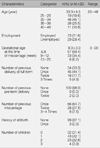Abstract
Purpose
The study aimed to explore the health consequences that women experienced after miscarriage and the factors related to them.
Methods
A convenience sample consisting of 102 women who had miscarried within 2 years was used. Women were recruited from hospitals and enterprises in Seoul and Gyeong-Gi Province. Participants completed a self-administered questionnaire containing a physical and psychological symptoms checklist developed for this study.
Results
More than 40% of the miscarriages occurred after 9 weeks of pregnancy and 35% of women were found to have had a previous miscarriage prior to this study. Psychological symptoms were more prevalent and prolonged than the physical symptoms, furthermore, the frequencies of the symptoms experiencedwere not consistent with the duration of symptoms. Employed women and women with early miscarriages complained of more physical symptoms; however, psychological symptoms were not different according to women's characteristics. Employment was a significant factor affecting physical symptoms.
Conclusion
Health care professionals need to inform and educate women and the family of the potential health changes during the recovery after the miscarriage. Health consequences due to miscarriages also need to be incorporated in women's reproductive health care. Nursing care should consider factors of maternal age, employment status, and obstetrical conditions upon the apparent social changes.
Figures and Tables
References
1. Adolfsson A., Larsson P.G., Wiljma B., Bertero C. Guilt and emptiness: Women's experiences of miscarriage. Health Care Women Int. 2004. 25(6):543–560.

2. Armstrong D.S. Perinatal loss and parental distress after the birth of a healthy infant. Adv Neonatal Care. 2007. 7(4):200–206.

3. Armstrong D., Hutti M. Pregnancy after perinatal loss: The relationship between anxiety and prenatal attachment. J Obstet Gynecol Neonatal Nurs. 1998. 27(2):183–189.

4. Bhattacharya S., Townend J., Shetty A., Campbell D., Bhattacharya S. Does miscarriage in an initial pregnancy lead to adverse obstetric and perinatal outcomes in the next continuing pregnancy? BJOG. 2008. 115:1623–1629.

5. Black R.B. A 1 and 6 month follow-up of prenatal diagnosis patients who lost pregnancies. Prenat Diagn. 1989. 9(11):795–804.

6. Brier N. Anxiety after miscarriage: A review of the empirical literature and implications for clinical practice. Birth. 2004. 31(2):138–142.

7. Cho J.Y. The Experience of women after childbirth during childbirth period. 2001. Seoul: Chung- Ang University;Unpublished doctoral dissertation.
8. Cote-Arsenault D. The influence of perinatal loss on anxiety in multigravida. JOGNN. 2003. 32(5):623–629.
9. Farquharson R.G., Jauniaux E., Exalto N.. ESHRE Special Interest Group for Early Pregnancy (SIGEP). Updated and revised nomenclature for description of early pregnancy events. Hum Reprod. 2005. 20:3008–3011.

10. Fenster L., Hubbard A.E., Windham G.C., Waller K.O., Swan S.H. A prospective study of work-related physical exertion and spontaneous abortion. Epidemiology. 1997. 8(1):66–74.

11. Frost M., Condon J.T. The psychological sequelae of miscarriage: A critical review of the literature. Aust N Z J Psychiatry. 1996. 30(1):54–62.

12. Gjerdingen D.K., Froberg D.G., Chaloner K.M., McGovern P.M. Changes in women's physical health during the first postpartum year. Arch Fam Med. 1993. 2(3):277–283.

13. Griebel C.P., Halvorsen J., Golemon T.B., Day A.A. Management of spontaneous abortion. Am Fam Physician. 2005. 72(7):1243–1250.
14. Hutti M.H., de Pacheco M.A., Smith M. A study of miscarriage: Development and validation of the Perinatal Grief Intensity Scale. J Obstet Gynecol Neonatal Nurs. 1998. 27:547–555.
15. Kim M.K., Lee Y.W., Cho I.S., Lim J.Y. Changes of nursing needs of the hospitalization in preterm labor women. Korean J Women Health Nurs. 2009. 15(1):24–31.
16. Kim S.K., Jo A.J., Kim Y.K., Do S.R., Lee K.Y. The survey on the national fertility, family health and welfare in Korea. 2006. Seoul: Korea Institute for Health and Social Affairs.
17. Kim T.K., Yoo E.K. A correlational study on the level of importance and performance of postnatal care and its relationship with women's health status. Korean J Women Health Nurs. 1998. 4(2):145–161.
18. Korea National Statistical Office. The annual report of marriage statistics 2007. 2008.
19. Korea National Statistical Office. The survey of economically productive population. 2009.
20. Lee K.H., Koh M.S. Women's experience of abortion: phenomenological perspectives. J Korean Acad Nurs. 1994. 24(2):157–174.

21. Lok I.H., Yip A.S., Lee D.T., Sahota D., Chung T.K. A 1-year longitudinal study of psychological morbidity after miscarriage. Fertil Steril. 2009. 19:[Epub ahead of print].

22. Maconochie N., Doyle P., Prior S., Simmons R. Risk factors for first trimester miscarriage: Results from a UKpopulation-based case-control study. BJOG. 2007. 114(2):170–186.
23. Ministry of Labor. Labor standards act. 2008. Korea:
24. Neugebauer R., Kline J., O'Connor P., Shrout P., Johnson J., Skodol A., Wicks J., Susser M. Depressive symptoms in women in the six months after miscarriage. Am J Obstet Gynecol. 1992. 166:104–109.

25. Schytt E., Lindmark G., Waldenstrom U. Physical symptoms after childbirth: Prevalence and associations with self-rated health. BJOG. 2005. 112(2):210–217.

26. Swanson K.M.. Predicting depressive symptoms after miscarriage: A path analysis based on the Lazarus paradigm. J Women Health Gend Based Med. 1999. 9(2):191–206.

27. Thompson J.F., Roberts C.L., Currie M., Ellwood D.A. Prevalence and persistence of health problems after childbirth: Associations with parity and method of birth. Birth. 2002. 29(2):83–94.

28. Torpy J.M., Lynm C., Glass R.M. Miscarriage. JAMA. 2002. 288(15):1936. No abstract available.
29. Whelan E.A., Lawson C.C., Grajewski B., Hibert E.N., Spiegelman D., Rich-Edwards J.W. Work schedule during pregnancy and spontaneous abortion. Epidemiology. 2007. 18(3):350–355.

30. Yoo E.K., Lee S.H., Kim M.H. A study on the relationship between the experience of Sanhujori, the traditional postpartial care in Korea and present health status of chronic arthritis female patient. Korean J Women Health Nurs. 1998. 4(2):217–230.




 PDF
PDF ePub
ePub Citation
Citation Print
Print







 XML Download
XML Download